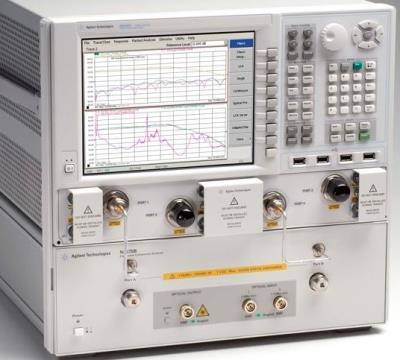
|
|
The Agilent N4375B Lightwave Component Analyzer (LCA) tests 10G Ethernet, FCx8, FCx10 and FCx16 electro-optical components, with up to 20 or 26.5 GHz modulation range. It comes in two basic versions. The economic line is based on a PNA-L network-analyzer and is available as a 2 port system. The high end version is based on the new PNA-X and offers true balanced measurements, extended optical modulation index (OMI) and is available with 2 or 4 ports. Both versions have the same specifications up to 20 GHz. The PNA-X based LCA is calibrated up to 26.5 GHz.
Specifications.
Optical test set.
Operation frequency range: 10 MHz to 20 GHz (Opt -322, -382), 10 MHz to 26.5 GHz (Opt -312, -314, -392, -394).
LCA optical input.
Operating input wavelength range: 1250 nm to 1640 nm.
Maximum linear average input power: +4 dBm (Input 1), +14 dBm (Input 2).
Maximum safe average input power: +7 dBm (Input 1), +17 dBm (Input 2).
Optical return loss (typical): > 27 dBo.
Average power measurement range: -25 dBm to +4 dBm (optical input 1), -15 dBm to +14 dBm (optical input 2).
Average power measurement uncertainty (typical): ±0.5 dBo.
LCA optical output.
Optical modulation index (OMI) at 10 GHz (typical): > 27% @ +5dBm RF.
Output wavelength: 1310 ± 20 nm, 1550 ± 20 nm (Opt -100, -102).
Average output power range: -2 dBm to +4 dBm.
Average output power uncertainty (typical): ± 0.5 dBo.
Average output power stability, 15 minutes (typical): ± 0.5 dBo.
External optical source input (-050).
Recommended optical input power: +8 to + 15 dBm.
Optical input power damage level: +20 dBm.
Typical loss at quadrature bias point: 9 dB.
Operating input wavelength range: 1290 nm to 1610 nm.
LCA RF test port input.
Maximum safe input level at port A or B: +15 dBm RF, 7V DC.
Options.
-312; 26.5 GHz, 2 port LCA based on N5242A-200.
-314; 26.5 GHz, 4 port LCA based on N5242A-400.
-322; 20 GHz, 2 port LCA based on N5230C-225.
-382; Integration of customer PNA-L.
-392; Integration of customer PNA-X (N5242A -200).
-394; Integration of customer PNA- X (N5242A -400).
-100; 1310 nm source optical test set.
-101; 1550 nm source optical test set.
-102; 1310 nm and 1550 nm source optical test set.
-010; Time domain.
-050; External optical source input.
-021; Straight connector interface (External 0.5 m patch cord).
-022; Angled connector interface (External 0.5 m patch cord).
|